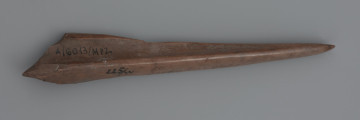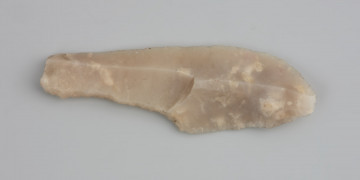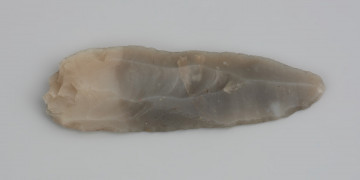
Perforator
9600 p.n.e. — 4100 p.n.e.
National Museum in Szczecin
Part of the collection: Court art of Pomeranian dukes in 16th and 17th century
A young woman, dressed in a Renaissance dress with a laced bodice and holding a chalice, stands in an indefinite interior with a window overlooking a mountainous landscape complete with architectural features. From behind her back, an old woman with a bundle of keys clipped to her belt leans out on the left. The scene by an unknown painter, based on the inscription on the painting, depicted the same figure, Sidonia von Borcke (1548-1620), as a young and old woman. This double portrait was painted at the end of the 18th century and was found in the palace in Stramehl (Łobez county) the ancestral seat of the von Borcke. It then found its way into the collection of the Society for Pomeranian History and Antiquity (Geselschaft für pommersche Geschchte und Altertumskunde) in Szczecin. The composition was based on a much earlier, 16th-century painting which, according to further accounts, was part of the collection of the Dukes of Pomerania and was given by Bogislav XIV (1580-1637) to the family of Schwalenberg from Starogard (Łobez county). It was supposed to depict a Pomeranian noblewoman, according to a tradition recounted over the years. However, a historian, Georg Sello (1850-1926), in his monograph on the von Borcke family, noted that the attire on the first model portrait dates back to the 1530s. i.e. a period before Sidonia was born. In the 1990s Janina Kochanowska (1948- ) interpreted the original representation as an allegory for the sin of debauchery. These portraits are now referred to as alleged representations. Sidonia von Borck, born in Stramehl, was court lady to Amelia of Saxony at the court of Philip I, Duke of Pomerania, in Wallachia. There, she became acquainted with Duke Ernest Ludwig, to whom she became engaged, but the wedding failed to take place. She was then said to have cast a curse on the ducal family, pronouncing that it would die out within 50 years. She never married, and towards the end of her life ended up in a monastery in Marianowo (Marienfließ), where she engaged in court battles with her brother over dowries and practised herbalism. Her confrontational nature and interests led to her being accused of witchcraft and having cast a curse on the ducal family, who had no continuity in descendants by this time. She was tried and then beheaded in 1620 in Szczecin, and her corpse was burnt at the stake. Her romantic story was described and popularised in the 19th century by Wilhelm Meinhold in his novel Sidonia von Bork, die Kolesterhexe (Sidonia von Borcke the witch of the cloister), and in the 21st century, the theme of her portraits was featured in Leszek Herman's book Sedinum. Message from the Underworld. Justyna Bądkowska
Author / creator
Object type
painting
Technique
oil technique
Material
canvas
Origin / acquisition method
acquisition
Creation time / dating
Creation / finding place
Owner
Muzeum Narodowe w Szczecinie
Identification number
Location / status

9600 p.n.e. — 4100 p.n.e.
National Museum in Szczecin

11900 p.n.e. — 11000 p.n.e.
National Museum in Szczecin

11900 p.n.e. — 11000 p.n.e.
National Museum in Szczecin
DISCOVER this TOPIC
National Museum in Lublin
DISCOVER this PATH
Educational path